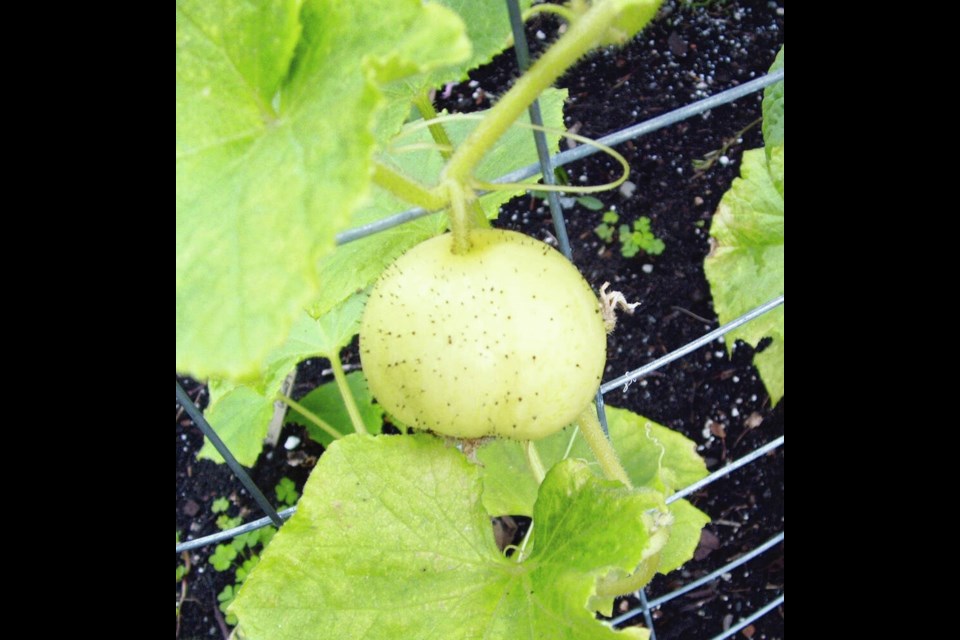Dear Helen: I recently came across a real curiosity in a friend’s garden. It was a round, pale yellow edible borne on a vine. My friend identified it as a “sort of” cucumber, grown from seeds she was given. Is this a new type of vegetable?
R.F.
No, it is actually an heirloom cucumber dating back to the 1800s. This variety is commonly called Lemon, but as is usual with older and heirloom varieties, many different strains, selected by different growers, exist, under various names like Apple, Crystal Apple, and Crystal Lemon.
The fruits are round and the size of a small apple. The skin is lemon coloured, the flesh lime green. These little cucumbers have a clean, crisp texture and a sweet, mild flavour that never turns bitter even with age.
The strain I’m growing this year is simply “Lemon” from Salt Spring Seeds. I always grow at least one vine, to provide refreshing little summer garden snacks.
Dear Helen: Our scarlet runner beans have flowered well, but few of the flowers have turned into beans. The blooms just fall off the tall vines.
D.B.
This question arrives in my mail at least once every summer, in hot weather.
The blossom drop you describe happens when the flowers are not pollinated or the weather is too hot. Runner beans, unlike common pole and bush beans, require pollination by bees or hummingbirds. They do best in cool summer weather and need a cool, consistently moist root run.
Don’t give up on them. As the weather cools they may begin producing pods. Meanwhile, keep them well watered and lay a heat-deflecting mulch over the root area.
Dear Helen: What is this “climbing zucchini” you mention occasionally in your columns? I notice you often include it when writing about growing vining edibles on vertical supports to save space.
C.G.
This vegetable is a prolific Italian summer squash that produces tall vines with long, slender fruits that swell slightly at the far, blossom end — an area that houses the seeds, making most of each squash wonderfully easy to slice or cut into slim sticks for dipping.
The shape of the fruits is commonly described as like a trombone. That has given rise to name variations among different strains of this heirloom squash. The one listed in the West Coast Seeds catalogue is Tromboncino. The variety I’m growing this year is Trombetta di Albenga, from Renee’s Garden.
Renee writes rather poetically about this “wonderful Italian heirloom summer squash” whose vigorous vines produce many “lime-green fruits with a curvaceous trumpet shape and a delicate mild taste with a hint of nutty artichoke flavour.
“Trombetta’s flesh is seedless and firm and doesn’t get watery or mushy like regular zucchini. The rambling plants will soon cover a trellis, fence of stakes with graceful fruits that hang like jade ornaments cloaked in a lush canopy of big, heart-shaped leaves”
I find the textures and flavours of this squash, the Italian ridged Romanesco types and the Middle Eastern varieties more interesting and pleasing than the more commonly grown dark-skinned kinds.
Dear Helen: The heathers I bought in one-gallon pots in the spring and planted in humus-rich, fertile soil have all died. I kept them well watered. When I unpotted them for planting, I did notice the pots were filled with a thick mass of roots, which I left intact. Could this have been the issue?
B.H.
I’ve noticed over the years that many gardeners fear to fiddle with the roots of newly purchased plants prior to planting. But it is crucial to detangle roots observed to be jumbled up or doing laps around the root ball. I always cut the roots back as well. This gives them a fresh start for venturing into new soil conditions.
Even when a purchased plant is not growing from a bunched tangle of roots I still straighten the roots out and trim them back before planting.
I try to avoid buying overgrown, root-bound plants whenever possible. I prefer small starter plants to larger specimens. They settle in and take off much more easily. For example, I buy heathers where I can find them in 10-cm wide pots. Every one of these small heathers that I’ve planted has grown wonderfully well in my garden, while several bought in larger pots have, like yours, withered away.



